Xôi
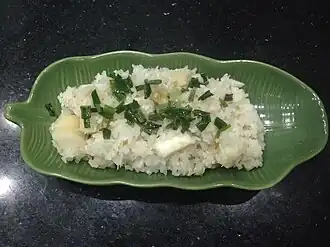 | |
| Type | Cơm |
|---|---|
| Course | Gạo nếp |
| Place of origin | |
| Associated cuisine | Vietnamese cuisine |
| Created by | Tai tribes |
| Invented | Middle Ages |
| Serving temperature | Hot or at room temperature. |
| Main ingredients | Sticky rice and pure water. |
| Ingredients generally used | Salt |
| Variations | Bánh bỏng, bánh chưng, bánh giầy, bánh đòn, bánh lá liễu, bánh ít, chè lam, cốm, cơm lam, cơm rượu, kem xôi, xôi chè |
Xôi (Vietnamese pronunciation: [soj˧˧]) is a traditional Vietnamese dish of sticky rice. With a history tracing back to Tai tribes in Southeast Asia, it became a staple crop in Vietnam partly due to the region's suitability for its growth. While somewhat replaced by other forms of rice which are easier to grow, it is still eaten in the modern era, prepared in a variety of different ways.
History
The development process of the customs around xôi is still debated. Although the civilizations of India and China are often thought to be the foundation of modern East and Southeast Asian culture, sticky rice and the customs revolving around it rarely appear in either region.[1][2] Instead, Southeast Asia has shown the rich development of sticky rice, with each country or ethnic group having unique ways of processing and consuming it.[3]
According to Vietnamese scholars, the customs related to sticky rice have followed the Tai tribes from Yunnan to the Northwestern region of Vietnam from the beginning of the Christian era.[note 1][4] This region is still the largest sticky rice growing in Vietnam,[5] partly because this rice variety is only suitable for high terrain with low water. As such, it was known as "the sticky rice zone" (vùng thâm canh lúa nếp).[6][note 2] Because of this, sticky rice has become a staple crop in Southeast Asian culture. Over the centuries, xôi – its finished product – has made very rich and diverse developments.[7][8]
Etymology
Since ancient times, there has been minimal research to explain the origin of the word "xôi" in the Vietnamese language or at least find a form of inter-text. According to researcher Trần Quang Đức,[note 3] the term is the manifestation of a dish made from "gạo nếp" (sticky rice) as almost the only ingredient. In Vietnamese dictionaries, this term is classified as single word, meaning it can be only a noun and not any other form.[note 4]
Older terms exist for Xôi which are now only used in rural areas, such as "cơm nếp" (Kinh) or "ꪹꪄ꫁ꪱ / khăw-nueng" (Tai), meaning "the meal of sticky rice".[9][10]
Use
Production

According to The Foundation of Vietnamese Culture (Cơ sở văn hóa Việt Nam, 1995) by Trần Ngọc Thêm,[note 5] Vietnamese people likely have a long history of using sticky rice (gạo nếp) as a basic daily food. However, it was inherently difficult to grow and often produces unstable yields, so over time, it has been replaced by wet rice (gạo tẻ).[note 6] Wet rice has gradually become the main staple food because of a few advantages: good drought tolerance, a harvest of at least two seasons per year (spring and autumn), and nutritional content. In addition, the price of sticky rice is always double the price of wet rice in the agricultural market. This type of rice is often called as "gem rice" (gạo ngọc) or even "heavenly rice" (gạo giời) in Vietnamese folklore.[13] This mainly comes from its round, white and glossy shape, as well as the high nutritional content.[14]
Compared to wet rice, sticky rice has many nutritional advantages, but it proved more difficult to process. First of all, sticky rice must be soaked in pure water (nước sạch) for a night to make its grains bloom bigger, thus ensuring softness after cooking. Before cooking (đồ xôi), sticky rice must be continually soaked with salt water (nước muối). A lack of salt will cause the grains of sticky rice to be "thin" (gầy).[note 7] As such, modern Vietnamese folklore has the saying: "If the bread is indispensable in yeast, how can sticky rice lack salt?".[note 8] After the preliminary processing, the taste of the rice is unchanged until it becomes xôi.[15][16]
Xôi can have four flavors: nuttiness (ngùi), flavourless (nhạt), salinity (mặn) and sweetness (ngọt). The nuttiness has significant popularity, while sweetness is very rare. The color of pure xôi is white, often called ivory (màu ngà), but it becomes more colorful when mixed with other foods (mostly cereals).
In modern Vietnam, xôi is considered one of the extra dishes (bữa phụ) to give nutrition after hard labor. It is also significant for important events of life, such as festivals, weddings, memorials for the deceased, and Lunar New Year.[17][18]
Consumption
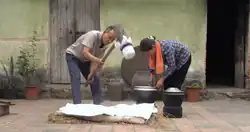
In the most classic and universal form, xôi is usually wrapped in leaves of arrowroot or sometimes banana and lotus. This method is to preserve the dish for two (summer) to three (winter) days, which is very convenient for making long journeys. Some people will fry xôi in a cast iron pan,[20] although this method is not very popular as the combination with the heat of metal is generally considered bad for the quality of sticky rice.[21]
The ethnic minority communities in the Northwest mountains of Vietnam have a different way of preparing xôi, which is called "cơm lam"[note 9] ("forest meal"). It is cooked in neohouzeaua or sometimes bamboo tubes rather than pots. During the cooking process, the essential oil of the wood penetrates the sticky rice to supplement fragrance and automatically solidifies into a thin biofilm to hold the rice grains. This practice is not originally due to lack, but for convenience for going into the forest for a long time.
Since the early 2010s, due to the influence of Thai tourism culture, there has been a trend among Vietnamese youth to eat xôi with banana, durian, jackfruit and mango, something that did not exist in previous decades. Its most common use is usually in combination with coconut milk. However, this dish (xôi xiêm, "siam xôi") is only suitable for summer.[22]
According to the Vietnamese philosophy of yin yang, sticky rice is inherently hot food, while wet rice is a mild one. It is therefore not recommended to eat Xôi excessively.[23][24] The claimed symptoms of eating too much xôi include abdominal pain, belching, difficulty excreting, and itchiness.[25] People with certain conditions are recommended not to use xôi as a meal, such as obesity, stomach pain, being stung, serious wounds, high fever, high blood pressure, pregnancy, gaining weight fast, and flatulence and indigestion.[26]
Xôi is usually combined with popular cereals to increase its flavor. Xôi is said to be extremely helpful when served with fish[27][28] because it overcomes the cold when absorbing dishes originating from the water[note 10] as an anti-cold food. However, xôi is not recommended with chicken, as according to Vietnamese folklore, these two dishes combined will make worms grow very quickly in the human body.[29][30] In addition, some other ingredients are also recommended not to be combined with xôi, such as chili, pepper, mustard, garlic, chicken eggs, beef, and especially dog meat. Xôi is also not recommended for cakes, as its stickiness can cause choking if pureed.[31][32][33] However, due to sticky rice's highest nutritional content of cereals, physicians often recommend the use of xôi for sick people or women who have just given birth. It is thought to stimulate the strength of the mother's condition and especially the milk gland, which is very beneficial for babies.[34]
Culture
Despite becoming less significant in everyday dishes, xôi remains significant to the Vietnamese people. It is a priority food for the deities and ancestors in every big occasion. It is also the main ingredient to make bánh chưng, bánh tét and bánh giầy, which are very important in the Tết Nguyên Đán.
Before synthetic glue was created, xôi was used by Vietnamese people as a specialized and cheap glue. However, it was only useful for paper and some thin items made from bamboo, such as hand fans, paper lanterns, and paintings.

- About October 1945, in order to celebrate the Declaration of Independence of new Vietnam, the people of Hanoi made 100 red xôi trays to offer to the altar of Saint Trần, whom was considered the forefather of the Vietnamese ethnic groups.
- Nam Định City is often known in travel guides as "the capital of xôi" (thủ đô xôi) in Vietnam. This comes from the abundance of the quality and way of processing xôi in the Old Quarters inside the city.[35][36]
- Hmong and Yao families in Vietnam often put a bowl of xôi with a few pieces of boiled pork at the door every night at the end of the year to invite the forest spirits (ma rừng) for eating.
- Candidates before entering the exam are often given xôi with beans (xôi đỗ/xôi đậu) by parents. Because in the pronunciation of Vietnamese people, "bean" (đỗ/đậu) is homogeneous with "passage [the exam]" (thi đỗ/thi đậu), therefore, this is a way to wish luck.
- According to Vietnamese law, death row inmates are allowed two hours[note 11] to enjoy a last meal (cơm đoạn đầu) before serving their sentence. Its composition consists of xôi with beans and chả (Vietnamese sausage).[37][38]
- In Vietnamese language, the raspberry is called "quả mâm-xôi" or "trái mâm-xôi" (means "fruit of xôi tray") because of its shape. Similarities: Cúc mâm-xôi (means "daisy of xôi tray")...
Varieties
Due to the diversity and richness of ways to prepare and display xôi, there are yet currently no official statistics on the number of dishes made from it. However, according to authors Thạch Lam[note 12], Vũ Bằng[note 13] and Toan Ánh[note 14], xôi can be classified into several groups according to form.[39]
- White xôi (xôi suông): The simplest and most common form. However, it is sometimes combined with fat, onions and fish sauce to enhance the flavor.
- Betel-flower xôi (xôi hoa cau): The mung beans are cooked with xôi what bloom like speckled flowers.
- Pudding xôi (xôi chè): Xôi with beans after cooking are then combined with chè (a pudding of cassava and coconut milk).
- Colory xôi (xôi màu): It is combined with cereals and lotus grains to create eye-catching colors.
- Meat xôi (xôi thịt): Pork, quail, sometimes chicken and eggs.
- Fish xôi (xôi cá): Usually fish and shrimp.
- Fruit xôi (xôi xiêm): Xôi is combined with popular fruits and lots of coconut milk for sweetness.
Flavors
(Note: The following reviews contain many superficial)
- Savory
Savory xôi are called xôi mặn in Vietnamese. They include the following varieties:
- Xôi ngô or xôi bắp – made with corn and smashed cooked mung beans
- Xôi cá – fried fish xôi
- Xôi chiên phồng – deep-fried glutinous rice patty
- Xôi gà – with chicken
- Xôi khúc – with mung bean filling with a coating of pandan leaves paste
- Xôi lạc (northern Vietnamese name; called xôi đậu phộng in southern Vietnam) – made with peanuts[40]
- Xôi lạp xưởng or xôi lạp xường – served with Chinese sausage, meat floss and boiled quail egg
- Xôi pate – served with pâté and ham
- Xôi sắn or xôi khoai mì – cooked with cassava
- Xôi thập cẩm – subgum xôi
- Xôi thịt kho – served with thịt kho tàu (caramelized pork and eggs)
- Xôi trứng – served with fried eggs, caramelized eggs or omelette
- Xôi xéo – served with smashed mung beans, fried onions, and rousong
- Xôi xíu mại – served with siu mai
- Sweet
Sweet xôi are called xôi ngọt in Vietnamese. They include the following varieties:
- Xôi bắp – made with corn, sugar, fried onions, and smashed cooked mung beans
- Xôi đậu đen – made with black urad beans
- Xôi đậu xanh – made with mung beans[41]
- Xôi dừa – made with coconut
- Xôi gấc – made with the aril and seeds of the gấc fruit[42]
- Xôi lá cẩm (also called xôi tím) – made with the magenta plant
- Xôi lá cẩm đậu xanh – made with the magenta plant and mung beans
- Xôi lá dứa – made with pandan leaf extract for the green color and a distinctive pandan flavor
- Xôi lúa – with boiled waxy maize, fried shallot and mung bean paste
- Xôi nếp than – made with black glutinous rice
- Xôi ngũ sắc – 5-colored xôi: purple from the leaf extract of the magenta plant, green from pandan leaf, red from gấc fruit, yellow from mung beans, and the white color of natural glutinous rice
- Xôi nhộng – made with silk worms
- Xôi sầu riêng – made with durian
- Xôi vị – hard cooked xôi with pandan leaves.
- Xôi vò – the glutinous rice grains do not stick together in this type of xôi, as they are coated with ground peeled-and-boiled mung beans
- Xôi xoài – made with coconut milk and fresh ripe mango; of Thai origin.
Gallery
-
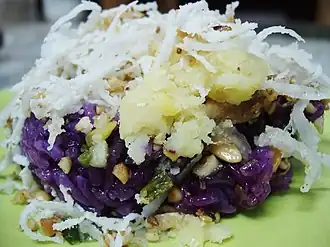 Purple xôi
Purple xôi -
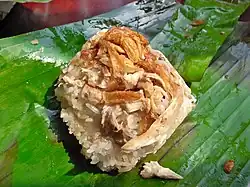 Xôi with chicken
Xôi with chicken -
Xôi in five colours
-
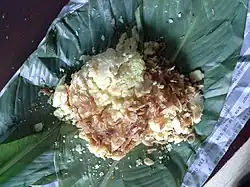 Cutting xôi
Cutting xôi -
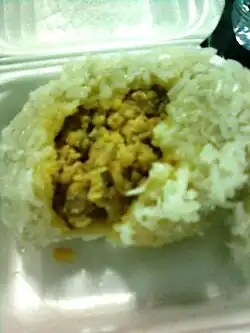 Xôi with bean flour
Xôi with bean flour -
Fried xôi
-
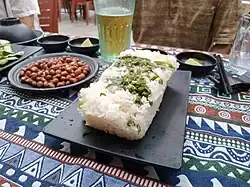 Xôi with fat and onions
Xôi with fat and onions -
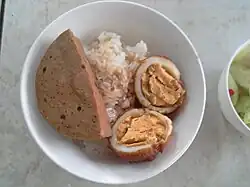 Xôi with giò and eggs
Xôi with giò and eggs -
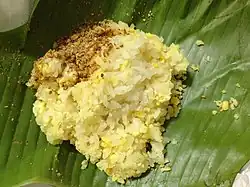 Xôi with mung beans
Xôi with mung beans -
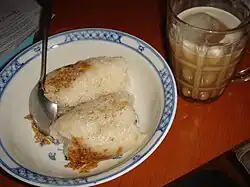 Xôi with yellow beans
Xôi with yellow beans -
Xôi with gac fruits
-
Xôi with meat fibers
-
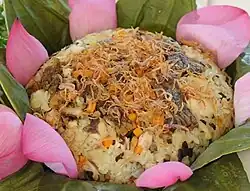 Xôi with perches
Xôi with perches
See also
- Bánh chưng
- Bánh giầy
- Bánh đòn
- Bánh lá liễu (紅桃粿)
- Chả
- Chè
- Cơm
- Khao lam
- Lemang
- Mango sticky rice (Kao niew mamuang)
- Okowa (おこわ)
- Zhú tǒng fàn (竹筒飯)
Notes and references
Notes
- ^ Nguyễn, Xuân Hiển (2001). Glutinous-Rice-Eating Tradition in Vietnam and Elsewhere. Bangkok: White Lotus Press. p. 13. ISBN 9789747534238.
- ^ Golomb, Louis (March 1976). "The Origin, Spread and Persistence of Glutinous Rice as a Staple Crop in Mainland Southeast Asia". Journal of Southeast Asian Studies. 7 (1): 1–15. doi:10.1017/S0022463400010237. S2CID 163052600.
- ^ Vân Trai Trần Quang Đức, Ngàn năm áo mũ : Lịch sử trang phục Việt Nam giai đoạn 1009–1945, Nhà sách Nhã Nam & Nhà xuất bản Thế Giới, Hà Nội, 2013.
- ^ Xôi
- ^ Trần Ngọc Thêm. Cơ sở văn hóa Việt Nam (The Foundation of Vietnamese Culture), 504 pages. Publishing by Nhà xuất bản Đại học Tổng hợp TPHCM. Saigon, Vietnam, 1995.
- ^ According to The Basis of Vietnamese Culture (fp. 1997 - rp. 2006) by Prof. Trần Quốc Vượng and colleagues, the formula for creating traditional Vietnamese cuisine was: Rice, vegetable, fish, meat. In particular, meat appeared later and is also less common.
- ^ "Lép" (poor), "gầy" (thin), "chắc" (thick) and "mẩy" (fat) are specialized terms in Vietnamese rice cultivation techniques, what are used to describe the quality of rice grains.
- ^ In Vietnamese : "Bánh mì nào thiếu tí men ; Thế thì gạo nếp phải phiền muối thôi".
- ^ By ideas of researchers Tạ Chí Đại Trường and Nguyễn Hùng Vỹ : K'lam, kẻ lãm, cổ lãm, cảm lãm, khả lam, gia lâm...
- ^ Sushi is always served with xôi to counteract the coldness of the seafoods.
- ^ From 3:00 to 5:00 AM.
- ^ Thạch Lam, Hà Nội băm sáu phố phường, Đời Nay Publishing, Hà Nội, 1943.
- ^ Vũ Bằng, Miếng ngon Hà Nội, Nam Chi Tùng Thư Publishing, Sài Gòn, 1960.
- ^ Toan Ánh work series : Nếp cũ, Nếp xưa, Phong tục Việt Nam, Việt Nam chí lược.
References
- ^ "A Taste of Sticky Rice, Laos' National Dish". Smithsonian Magazine. Archived from the original on 5 October 2021. Retrieved 17 July 2021.
- ^ Sing, Phia (2000). Traditional recipes of Laos : Being the manuscript recipe books of the late Phia Sing, from the Royal Palace at Luang Prabang, reproduced in facsimile and furnished with an English translation. Prospect Books. p. 183. ISBN 0-907325-60-2. OCLC 1342532853.
- ^ Ramsay, Gordon (12 May 2011). Gordon's Great Escape Southeast Asia: 100 of my favourite Southeast Asian recipes. HarperCollins UK. ISBN 9780007384525. Retrieved 8 September 2013.
- ^ Rộn ràng ngày xuân trên cánh đồng lớn nhất vùng Tây Bắc (vi)
- ^ Nếp nương Điện Biên - đậm bản sắc Tây Bắc
- ^ Olsen, Kenneth M; Purugganan, Michael D (1 October 2002). "Molecular Evidence on the Origin and Evolution of Glutinous Rice". Genetics. 162 (2): 941–950. doi:10.1093/genetics/162.2.941. PMC 1462305. PMID 12399401.
- ^ Delforge, Isabelle (2001). "Laos at the crossroads". Archived from the original on 5 September 2008. Retrieved 15 April 2003.
- ^ Sattaka, Patcha (27 December 2016). "Geographical Distribution of Glutinous Rice in the Greater Mekong Sub-region". Journal of Mekong Societies. 12 (3): 27–48. ISSN 2697-6056. Archived from the original on 8 November 2021. Retrieved 10 June 2021.
- ^ Khảu nửng
- ^ Tai cuisine : The dishes of plant origin (vi)
- ^ Chõ xôi trong gia đình người Thái Tây Bắc
- ^ Ninh đồng (mỏ nửng) của dân tộc Thái
- ^ Distinguish sticky rice from wet rice
- ^ How does sticky rice work for health ?
- ^ The secret of cooking to soft and fat xôi
- ^ How to soak sticky rice to cook xôi
- ^ Xôi in Vietnamese culture
- ^ The dish is in a hurry but it witnessed each life milestone
- ^ A unique cake, what the stronger the forced, the better it is (vi)
- ^ Xôi Tết ăn mãi không hết, mẹ hãy biến tấu thành những món tuyệt ngon ai cũng thích mê (vi)
- ^ Đừng đồ xôi theo cách thông thường, biến tấu một chút thành món ăn siêu ngon (vi)
- ^ Khám phá món ngon độc đáo của miền biên giới Tây Nam - xôi xiêm (vi)
- ^ Is eating a lot of xôi good ?
- ^ Should we eat sticky rice daily ?
- ^ Xôi is "very toxin" for some groups of people
- ^ Although sticky rice is very delicious, there are still people who should not eat it
- ^ Fish xôi - The dish is both strange and familiar
- ^ How to make fish xôi
- ^ Five foods are advised not to use with chicken
- ^ Do not eat xôi with chicken, why ?
- ^ Delicious but deadly mochi : The Japanese rice cakes that kill
- ^ Japan confronts mochi rice-cake death-trap with technological solution
- ^ Mochi choking deaths skyrocket in Japan with the New Year
- ^ The usefulness of xôi for women has just given birth
- ^ A xôi shop has more than 60 years of crowded customers in Namdinh City
- ^ A specialty is both fragrant and fat
- ^ What is the last meal of the death row inmate ?
- ^ What standards must the last meal of the death row inmate ensure ?
- ^ Xôi - The national dish (vi)
- ^ "Way to easily cook delicious xôi lạc" (in Vietnamese). 14 November 2013. Retrieved 4 March 2017.
- ^ Thanh Lê (7 January 2015). "Tricks to simply make xôi đậu xanh by rice cooker" (in Vietnamese). Khỏe & Đẹp. Phunutoday.vn. Retrieved 4 March 2017.
- ^ "How to make delicious xôi gấc for New Year celebrations" (in Vietnamese). Retrieved 4 March 2017.
Further reading
Bibliography
- George Coedes. The Making of South East Asia, 2nd ed. University of California Press, 1983.
- Trần Ngọc Thêm. Cơ sở văn hóa Việt Nam (The Foundation of Vietnamese Culture), 504 pages. Publishing by Nhà xuất bản Đại học Tổng hợp TPHCM. Saigon, Vietnam, 1995.
- Trần Quốc Vượng, Tô Ngọc Thanh, Nguyễn Chí Bền, Lâm Mỹ Dung, Trần Thúy Anh. Cơ sở văn hóa Việt Nam Archived 31 May 2024 at the Wayback Machine (The Basis of Vietnamese Culture), 292 pages. Re-publishing by Nhà xuất bản Giáo Dục Việt Nam & Quảng Nam Printing Co-Ltd. Hanoi, Vietnam, 2006.
- Li Tana (2011). Jiaozhi (Giao Chỉ) in the Han period Tongking Gulf. In Cooke, Nola; Li Tana; Anderson, James A. (eds.). The Tongking Gulf Through History. University of Pennsylvania Press. pp. 39–44. ISBN 9780812205022.
- Li Tana, Towards an environmental history of the eastern Red River Delta, Vietnam, c.900–1400, Journal of Southeast Asian Studies, 2014.
- Samuel Baron, Christoforo Borri, Olga Dror, Keith W. Taylor (2018). Views of Seventeenth-Century Vietnam : Christoforo Borri on Cochinchina and Samuel Baron on Tonkin. Cornell University Press. ISBN 978-1-501-72090-1.
- Gibbs, JC (18 May 2018). "FORKLIFE: Children of Sticky Rice". Smithsonian Center for Folklife and Cultural Heritage. Archived from the original on 8 November 2021. Retrieved 10 June 2021.
External links
- English
- Xôi – the quintessential comfort food
- Xôi (sticky rice) - a common dish of Vietnam
- Vietnamese sticky rice (xôi) : A great choice for your quick breakfast
- Xôi types : A complete guide to Vietnamese sticky rice
- Vietnamese sticky rice (xôi) : A must-try for your upcoming food tour
- The xôi trays has unique shapes in Phú Thượng village
- Vietnamese
